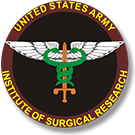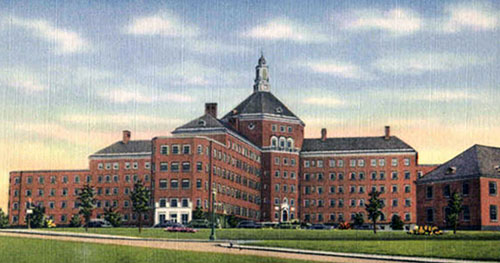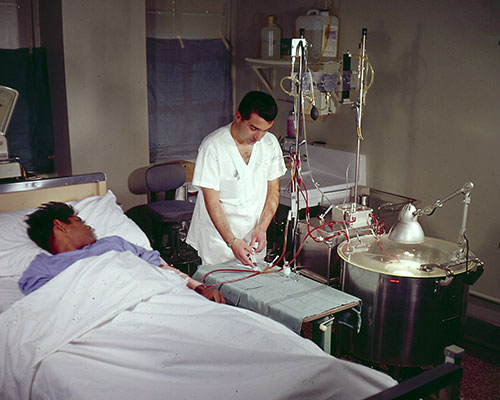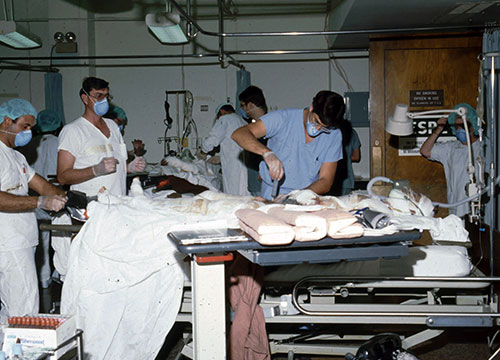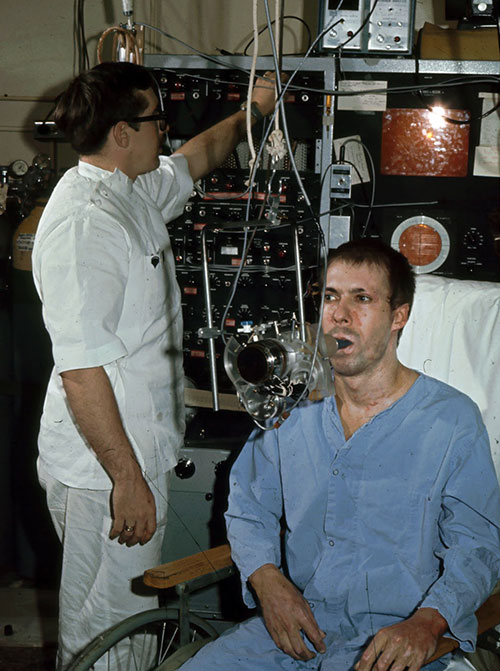USAISR History
USAISR Origins
The Institute of Surgical Research (USAISR), originally named the Surgical Research Unit, was established in 1943 at Halloran General Hospital, Staten Island, New York.
Its mission was to evaluate the role of newly discovered antibiotics in the treatment of war wounds.
Move to San Antonio
In 1947, the Institute, with its 12 assigned personnel, moved to Brooke General Hospital, Fort Sam Houston, Texas. At that time, in addition to the study of antibiotics, the Institute was also charged with the study of innovative new surgical techniques and developments.
Then in 1949, due to concern regarding the large number of possible casualties generated by nuclear weapons, the Institute's mission was further expanded to include the study of thermal injury. The advent of improved grafting procedures and continued use of antibiotics in new applications grew with this mission.
In May 1953, the Institute became a Class II activity of the Surgeon General. It was later assigned to Headquarters, United States Army Medical Research and Development Command in September 1958.
During this period the Institute evaluated forward thinking medical research initiatives, including the use of plasma extenders, grafting and preservation of blood vessels, and the use of an "artificial kidney."
As the "Army's Burn Unit," this unit served as a prototype and model for civilian burn units all over the world and was a premier dialysis research center serving South Central Texas and neighboring states.
Becomes MRMC Subordinate Command
As part of the Army Medical Department reorganization in March 1994, the Institute became a subordinate command of the Medical Research and Materiel Command, itself a major subordinate command of the newly formed Medical Command (MEDCOM).
In 1996, the Institute moved to its current location adjacent to the newly constructed Brooke Army Medical Center. At this time, the research focus of the mission changed from thermal injury to the full spectrum of combat casualty care.
The Institute of Surgical Research is a highly decorated and celebrated unit. The Institute has been involved in humanitarian missions to foreign countries such as the Union of Soviet Socialist Republics in 1989, Guam in 1997, and Honduras from 1999 to present.
Expertise Widely Utilized
The Institute has utilized its expertise by caring for burn casualties from every conflict since World War II to Operation Iraqi Freedom and Operation Enduring Freedom, including the 1979 Marine Base fire in Camp Fuji, the 1983 bombing in Beirut, and the 1994 Pope Air Force Base plane crash, as well as dozens of other medical emergencies.
As a result of the 2005 Base Realignment and Closure, in 2010, the combat casualty care research sub-function of Walter Reed Army Institute of Research (from Forest Glen, Maryland) and the Army Medical Research Detachment (from Brooks City-Base, Texas), were co-located and integrated into the USAISR.
In addition, the Army Dental and Trauma Research Detachment from Great Lakes, Illinois, became a subordinate unit of the USAISR.
With the addition of these units, the Institute has grown from a 12 person staff in 1943 to over 700 military and civilian personnel at present. It continues to serve as the primary Combat Casualty Care research facility for the Army.
Moreover, while continuing its excellence in the field of burn care management, the Institute has expanded and placed equal emphasis in providing medical solutions for the injured warfighter on the battlefield.
Formation of the Battlefield Health & Trauma Research Institute
Also, as a result of the 2005 Base Realignment and Closure, the Battlefield Health and Trauma Research Institute (BHT) was formed.
This included the construction of a new building adjacent to San Antonio Military Medical Center (SAMMC) and connected to the USAISR building, permitting all Department of Defense (DoD) combat casualty care research (minus neuroprotection) to be co-located with the USAISR. This in turn allowed the following Navy and Air Force activities to be added to the BHT:
- The Naval Medical Research Unit-San Antonio (NAMRU-SA), received the combat casualty and research sub-function of the Naval Medical Research Center from Forest Glen, MD, and the Naval Institute for Dental and Biomedical Research from Great Lakes, IL.
- The United States Air Force Dental Evaluation and Consultation Service (DECS) from Great Lakes, IL.
USAISR Technical Milestones
- Cold-Stored Platelets (CSP) – 2019: Platelets are the blood cellular component responsible for blood clotting and hemorrhage control. USAISR research led to a Food and Drug Administration-approved extension of the shelf life of this vital blood product from 3 to 14 days and improved the safety of the product. CSP have been used to stop bleeding and save the lives of combat casualties in the U.S. Central Command since 2016.
- Compensatory Reserve Index – A device that detects when a patient is going into hemorrhagic shock received clearance from the Food and Drug Administration in December 2016 for use in pre-hospital and hospital settings.
- 75th Ranger Regiment's Ranger O Low Titer Whole Blood Program – 2016 Maj. Gen. Harold J. Greene Award for Innovation, also known as the Army's Greatest Innovation Award: The program identifies all blood group O members of the unit and then tests them to determine possible donors to be used at the point of injury.
- SAM Junctional Tourniquet – 2015 Major General Harold "Harry" J. Greene Award for Innovation: The tourniquet is designed to stop bleeding in junctional areas of the torso where limb tourniquets cannot be used like in the pelvic area or armpits.
- Burn Flight Team Uses CRRT During Transport – On November 2015, during its second mission to Singapore, the Burn Flight Team a kidney dialysis machine to provide continuous renal replacement therapy for the first time inflight. CRRT is routinely used in the Burn Intensive Care Unit to purify the blood of toxins through a filtration system and assist in fluid removal.
- Burn Navigator – Also known as Burn Resuscitation Decision Support System-Mobile received 510(k) clearance from the U.S. Food and Drug Administration for a medical device in 2013.
- Burn Flight Team Sets Record – The team set a new record on February 2013 for the longest continuous flight by flying for 19 hours on a non-stop flight from Singapore to San Antonio, traveling more than 9,850 miles, which surpasses its previous longest flight by more than 3,000 miles.
- Burn Flight Team Transports Patient on ECMO – The Burn Flight Team, Brooke Army Medical Center's extracorporeal membrane oxygenation team, as well as the 59th Medical Wing's Critical Care Air Transport Team successfully transported a patient from the Brooke Army Medical Center to New York City for the first time on January 2013. ECMO is a heart-lung bypass system that offers a lifesaving capability for patients who aren't doing well on a ventilator.
- Freeze-Dried Plasma (FDP) for Special Operations Command (SOCOM) – 2012: USAISR partnered with the Armed Services Blood Program (ASBP), the French Military Medical Services and the Food and Drug Administration to establish a program for manufacturing FDP in France from plasma collected by ASBP and distributing it throughout SOCOM. USAISR was instrumental to organizing the program, testing FDP and establishing the standard operating procedures for SOCOM.
- Combat Gauze – 2008 Army Greatest Invention: A large-sized flexible roll of non-woven medical gauze impregnated with a clotting agent known as kaolin. The dressing can be used on surface wounds and has been proposed to treat deep bleeding at the end of a long wound tract.
- Damage Control Resuscitation of Severely Injured Soldiers – 2007 Army Greatest Invention: DCR limits fluid resuscitation, stabilizing the patient's blood pressure to minimize renewed bleeding from recently formed blood clots. Blood volume is restored using plasma along as the primary resuscitation fluid, with packed red blood cells.
- Combat Application Tourniquet (CAT) – 2005 Army Greatest Invention: A small lightweight tourniquet that completely occludes arterial blood flow in an extremity. The CAT can be applied with one hand if necessary via a windlass to tighten its strap.
- HemCon Chitosan Dressing – 2004 Army Greatest Invention: Made from chitin found in shrimp shells that bonds with blood cells to form a clot. The dressing can withstand blunt force as well as extreme field conditions, including inclement weather,temperature and rugged terrain.
- Flame-Resistant Army Combat Shirt (FR-ACS): Garment reduces the incidence and severity of burn injuries from improvised explosive devices, and helps Soldiers combat heat stress. The unique production process fuses flame-suppressant gas compounds to fibers deep within the shirt's fabric, increasing fire protection while maintaining comfort and maneuverability.













